You are in:

1,000m
Check
and Service |

Ford
Anglia 105E - 1,000 Mile (1,600 km) Check and
Service Schedule
| It is impossible
to over emphasise the importance of correct
lubrication, inspection and running adjustments,
if you wish to obtain the best level of service
from your Ford Anglia. Every 1,000 miles (1,600
km) the following work, mainly lubrication,
should be carried out. (This periodic service was
extended to every 2,500 miles). The 1,000 / 2,500 Mile service also
incorporates:
(Key: This Colour = Daily Service items, This Colour
= Weekly
Service items)
Check
the Engine Oil
Level
Check the Radiator
Level
Check the Petrol
Level in the Tank
Check the Windscreen is Clean
Check the Battery Electrolyte Level
Check the Brake and
Clutch Fluid Reservoir Levels
Check the Operation
of all Lights
Check the Tyre
Pressures
Check the Gearbox Oil Level
Check the Rear Axle Oil Level
Check the Steering Box Oil Level
Check the Fan Belt Adjustment
Check the Clutch Adjustment at Operating Cylinder
Check the Windscreen Washer Level (where fitted)
Check the Seat Belts for Security and Wear (where
fitted)
Lubricate all Grease Gun Points (L1 - L5)
Lubricate Linkages and Locks
Lubricate the Distributor
|
Check the Gearbox Oil Level
With the car
standing on level ground, remove the combined
filler and level plug, which is located on the
side of the gearbox. Check the oil level, which
should be level with the bottom of the filler
plug hole. If required, top up with Extreme Pressure Gear Oil. The oil may be added by
means of a suitable gun through the combined
level and filler plug until the level reaches the
bottom of the filler plug hole. Replace the
filler plug and tighten securely.The
oil in the gearbox should be maintained to the
level of the filler plug at all times.
Insufficient oil will accelerate wear on the
gearbox parts, whilst too high an oil level may
result in the oil passing into the clutch housing
with consequent ill effects on the clutch facings
|
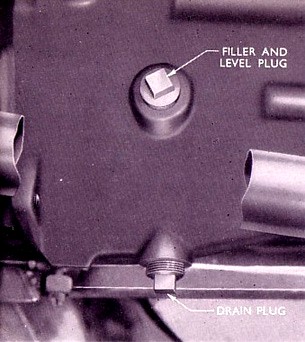 |
Check the Rear Axle Oil
Level
With the car standing on level ground, remove the
combined filler and level plug, which is located
halfway up the axle (on earlier cars there is
also a drain plug located in the bottom of the
axle.) Check the oil level, which should be level
with the bottom of the filler plug hole. If
required top up with the correct Grade of Oil until the level reaches
the filler plug hole.NOTE
– Only Hypoid and not
ordinary gear oil is to be used in the rear axle.
Replace the filler
plug and tighten securely. Periodically check the
tightness of the filler plug.
|
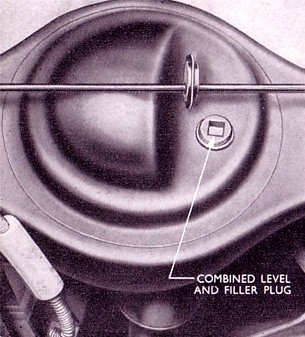 |
Check the Steering Box Oil
Level (Anglia)
With the car standing on level ground, remove the
rubber plug on top of the steering box. Check the
oil level, which should be level with the filler
plug hole. If required top up with Extreme Pressure Gear Oil until the level reaches
the filler plug hole.Replace the rubber plug.
The Steering Gear is of the worm and nut and
apart from the periodic lubrication described
above, requires adjustment and attention only at
fairly long intervals
|
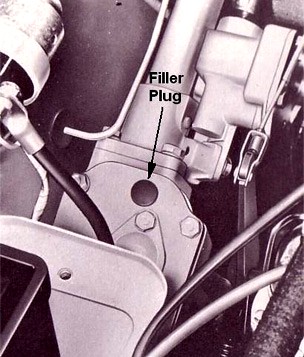 |
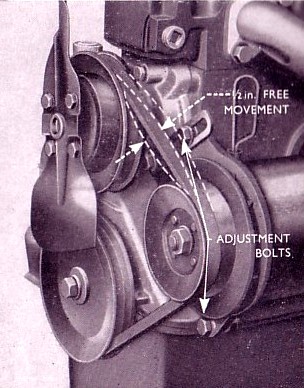 |
Check the Fan Belt
Adjustment
The same V-Shaped belt drives both the generator
and water pump. The belt adjustment is correct
when, as it is pushed and pulled at a point
midway between the generator and water pump
pulleys, the total movement of the belt does not
exceed ½ in (12.7mm). A loose belt causes slip
on the pulleys, while excessive tightness results
in wear on the generator and water pump bearings
and the belt itself.To adjust the fan belt
tension, loosen the two generator lower mounting
bolts, one at the front and one at the rear, then
loosen the adjustment locking screw at the front
of the generator. This will allow the generator
to be moved outwards, the adjustment screw
sliding in the slotted arm.
When the correct
tension is obtained, tighten all three bolts
securely.
|
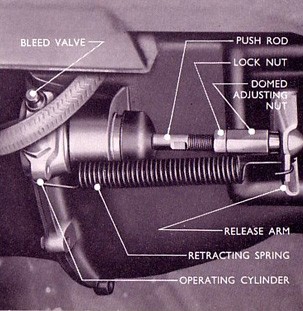 |
Check the Clutch Adjustment
At Operating Cylinder
The amount of free travel on the clutch release
arm should be checked and adjusted if necessary.
The clearance between the end of the clutch
operating rod adjusting nut and the clutch
release arm should be 1/16 in (1.6mm)
Compensation for wear is easily made by adjusting
the length of the clutch operating rod. To obtain
the correct clearance, disconnect the release arm
return spring, slacken the operating rod locknut
and turn the domed adjusting nut at the end of
the push rod clockwise to increase the free
movement and anti-clockwise to reduce it.After
making the adjustment, ensure that the locknut is
tightened and the return spring is re-located.
|
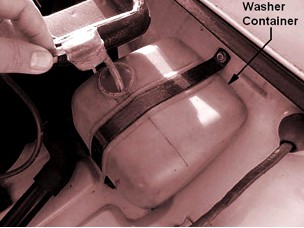 |
Check the Windscreen Washer
Level (where fitted)
The windscreen washer container is located on the
left hand side of the engine compartment on the
bulkhead next to the heater.The
container is made of an opaque plastic and so you
should be able to see whether the windscreen
washer fluid needs topping up. If the level is
low, remove the cap from the container and fill
with a suitable screen wash solution. Refit the
container cap.
|
Check the
Seat Belts for Security and Wear (where
fitted)
Check along the length of the webbing on each
belt to see if there are any nicks or tears in
the material. Sit in the vehicle and then test
the buckle, making sure that it opens and closes
smoothly and does not stick. Gently pull on the
closed buckle to see if it is secure. Check that
the seat belt adjustment works correctly by
adjusting the belt to see that the belt moves
smoothly through the adjuster and does not snag
on anything. (Remember to re-adjust it to your
needs before using the car.)Warning
- If the belts look defective in
anyway, or you are unsure about what to look for,
have the belts checked by your Authorised Ford
Dealer or a trained Mechanic. Do not take risks.
Your life may depend on the security of the seat
belts.
Lubricate
all Grease Gun Points
It is essential that a high-pressure grease gun
be used to force a good quality grease in to
parts equipped with the conical shaped non-return
lubricators (grease nipples).
A
Grease Gun can be purchased from your Authorised
Ford Dealer. To fill the grease gun, remove the
cap and plunger, pack the body with grease
solidly excluding as much air as possible, then
replace the cap and plunger. Use a high grade
grease for all bearing surfaces.
It
is important that dirt and old grease are cleaned
from around the lubricators before applying a
grease gun to them.
The
lubrication Chart below shows the approximate
position of the lubricators.
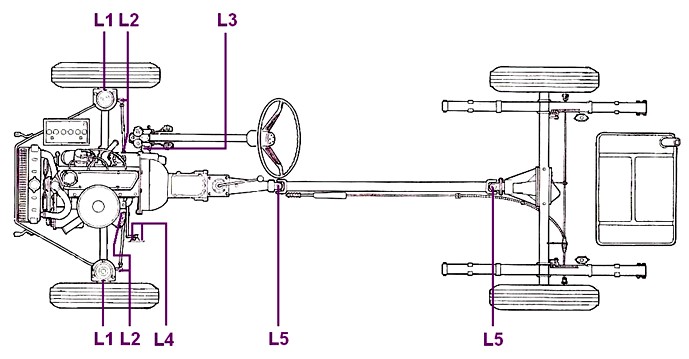
For convenience
the grease gun points are also briefly described
separately after the chart.
|
Grease Gun Point –
Track Control Arm - (L1)
The ball joint at the outer end of each track
control arm support is fitted with a lubricator,
which can be reached from beneath the front of
the car, forward of the front suspension cross
tube.

Grease
Gun Point – Track Rods - (L2)
The ball joint at each end of the right and left
hand track rods are fitted with grease gun
lubricators.
|
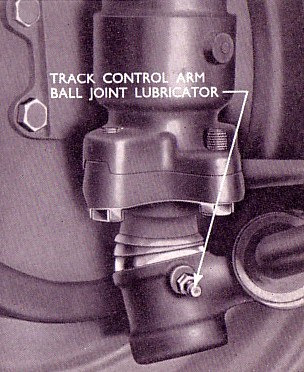 |
Grease Gun Point –
Steering Arm to Idler Arm Rod - (L3)
A lubricator is fitted at each end of this rod to
facilitate lubrication at the ball joints.
Grease Gun
Point – Idler Arm (L4)
The upper support bearing on the idler arm
bracket has a lubricator fitted in the centre of
the retaining cap nut
|
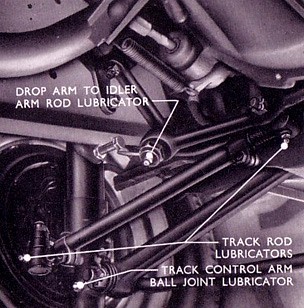 |
Grease Gun Point –
Universal Joints - (L5)
Each universal joint is fitted with a lubricator
at the centre of the spider. Apply a gun
containing SAE 250 oil or multi purpose lithium
base grease at these points and lubricate as
necessary |
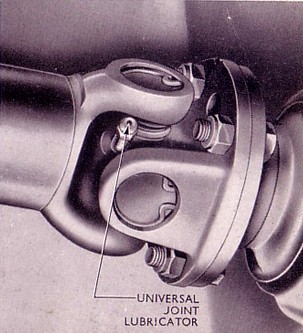 |
Lubricate
Linkages and Locks
A few drops of light oil should be applied to the
accelerator linkage bearings, hand brake
clevises, bonnet hinges, door hinges and locks,
etc.The
door locks may be lubricated through a small hole
in the rear edge of each door, above the lock.
Make sure that all runs or drips of oil that are
visible on the doors are wiped away with a clean
dry cloth to prevent the soiling of clothing when
entering the vehicle.
|
Lubricate the Distributor
Release the two spring clips and remove the
distributor cap and rotor. Apply one or two drops
of engine oil at the cam retaining screw and
spindle to lubricate the distributor shaft
bearings.Apply a thin film of petroleum jelly to
the contact breaker cam and lubricate the contact
breaker pivot post with a small film of engine
oil, ensuring that the contact breaker points are
not contaminated. |
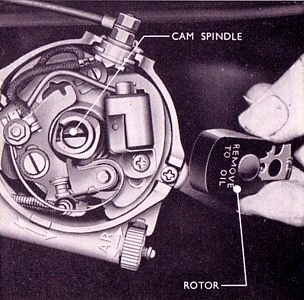 |
Information taken from Various Ford
Anglia Instruction Books and Handbooks.

Warning -
The Health and Safety bit.
Please note your health may be at
risk if you do not take sensible safety
precautions. Never work under an unsupported
vehicle, do not take shortcuts. If you feel that
the task is beyond your capabilities, then employ
the services of a trained professional. The Owner
of this Website nor the author cannot be held
responsible for any accidents or injury arising
from advice given on this webpage. Safety advice
can be obtained from the RoSPA.
|




|
|

